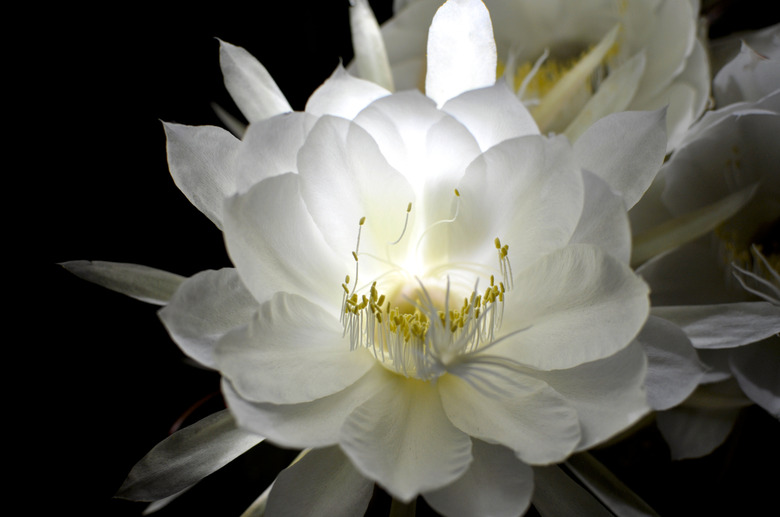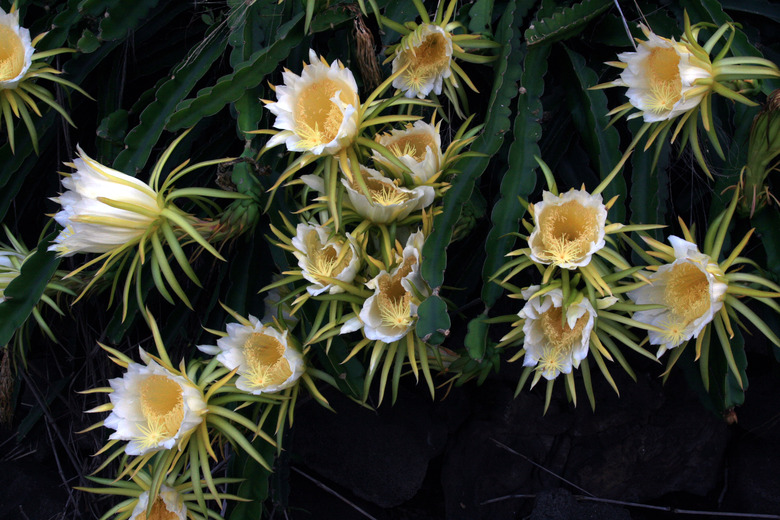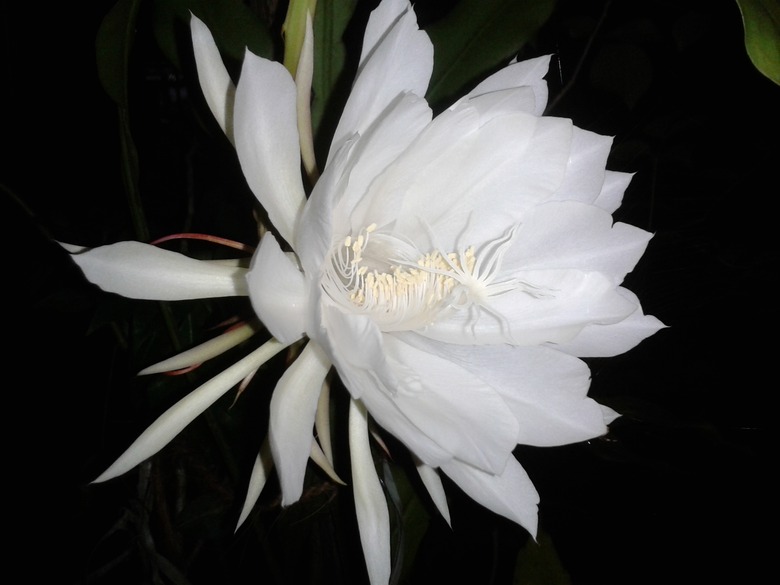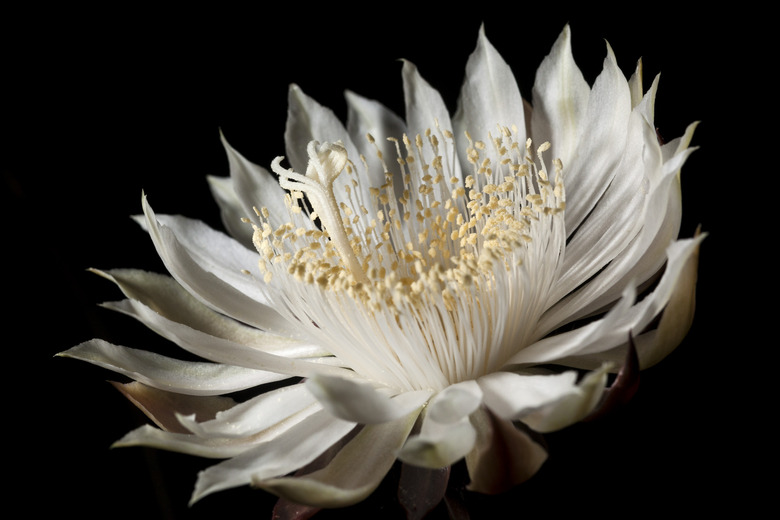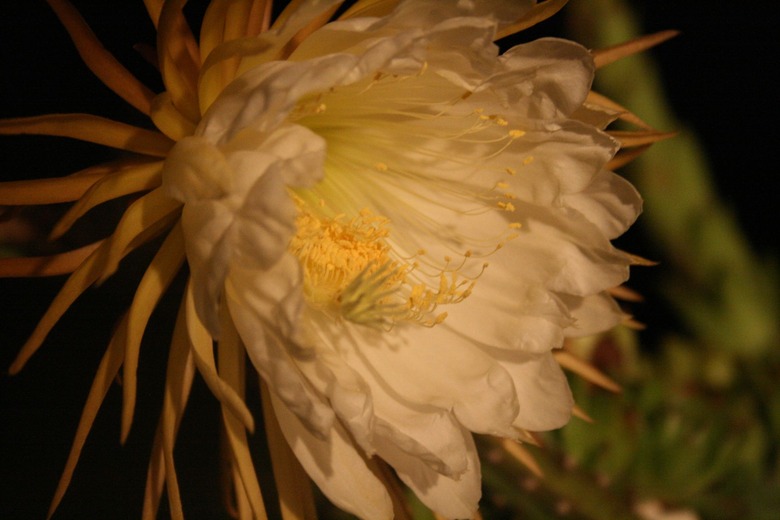How To Care For A Night-Blooming Cereus
If you love night-blooming cereus, which one? At least four cacti that bloom at night are referred to as night-blooming cereus. Some gardeners call any cactus that blooms at night by this name.
Whatever the name, if you have any of these plants in your landscape, the care is the same.
Types of Night-Blooming Cereus
Night-blooming cereus plants not only span different species, but they also have scientific names that have gone through numerous iterations. However, they all are members of the Cactaceae family.
Tip
All night-blooming cereus also share the common name Queen of the Night, even though these night bloomers span multiple genera and species.
All are succulents that produce showy flowers in either white, pink or yellow at night. The flowers tend to be large, from 6 to 14 inches in diameter. They open at dusk, usually last only one day, and wither before dawn. Here's a rundown.
Dragon Fruit (Pitaya)
Valued in Hawaii for its stunning night blooms and subsequent fruit, dragon fruit (Selenicereus undatus, USDA hardiness zones 9 to 11) has multiple other common names. You might see it called belle of the night, Cinderella plant, moonflower, Honolulu queen, red pitaya or strawberry pear. In addition, its botanical name used to be Hylocereus undatus.
Of all the species in the genus, dragon fruit is the most popularly cultivated, prized for its soft, mild flesh with tiny black seeds. However, it has a spiny exterior, hence its name.
**Specific growing requirements:** Requires acidic soil with a pH below 6.0.
Orchid Cactus
Orchid cactus is a tropical epiphyte, which means it grows not in soil but on the surface of another plant, where it takes up nutrients and moisture from the air, rain or natural debris around it.
Orchid cactus (Epiphyllum oxypetalum, zones 10 to 11) also has multiple common names, including lady of the night, jungle cactus and dutchman's pipe cactus, due to its curved tube.
It can grow quite tall—up to 10 feet—so if you're growing it in a container, it will likely need support. Furthermore, its native habitat is a rainforest, so it needs more water than some cacti.
**Specific growing requirements:** Requires acidic soil with a pH below 6.0.
Arizona Queen of the Night
This plant is native to the Arizona, Texas and northern Mexico deserts. It produces multiple slender stems and blooms that some liken to vanilla in fragrance.
Unlike other cacti, this species (Peniocereus greggii, zones 9 to 10) flowers just once a year, usually in June or July, and then may appear dead the rest of the year.
**Specific growing requirements:** Requires a dryer environment than other night-blooming cereus.
The species Selenicereus grandiflorus, zones 10 to 12, is the night-blooming cereus variety that has just one common name, Queen of the Night cactus. Botanical synonyms are Cereus calycanthus and Cereus grandiflorus.
This night bloomer produces enormous flowers, up to 14 inches in diameter.
**Specific growing requirements:** Handles a wider range of soil pH than other night-blooming varieties, from slightly acidic to slightly alkaline (pH 6.1 to 7.8).
Care of Night-Blooming Cereus
These plants all share similar requirements.
- **Temperature:** These plants like it warm, from 60 to 80°F. If they're growing outside, bring them indoors when the thermometer drops.
- **Soil:** Night-blooming cereus must have good drainage to avoid root rot, so use a potting soil mix designed for succulents that contains perlite or coarse sand, and make sure the pot has drainage holes.
- **Light:** They prefer bright, indirect light and may dry out or fail to thrive in full sun. If you grow them indoors—which is likely, given their narrow growing ranges—place them near a window so they get enough sun, but avoid midday sun exposure by pulling a shade or otherwise protecting them from intense heat and sun.
- **Irrigation:** Notwithstanding that these are cacti, they all (except for Peniocereus greggii) prefer moist soil and regular watering, especially when they are blooming. Water thoroughly and frequently, but only when the top inch or so of soil is dry. In winter, if they are not blooming, cut back on watering to once or twice monthly. Avoid overwatering.
- **Fertilizing:** Cacti need little fertilization but can benefit from a balanced cactus fertilizer applied every six weeks during the growing season and before flowering, which usually means applying fertilizer in late winter or early spring.
- **Repotting or Transplanting:** Most cacti like being somewhat rootbound, so wait until the potting soil has degraded, usually every two to three years, before repotting. Choose a container only slightly larger than the existing pot if the roots are root bound.
References
- North Carolina State Extension: Selenicereus Undatus
- North Carolina State Extension: Epiphyllum Oxypealum
- University of Arkansas: Plant of the Week: Night Blooming Cereus
- Succulent City: Night Blooming Cactus Varieties & How To Care for Them
- Almost Eden Nursery: Enjoying Epiphyllums – Including Night Blooming Cereus and Hybrid Orchid Cacti
- The National Gardening Association: Queen of the Night (Selenicereus grandiflorus)
